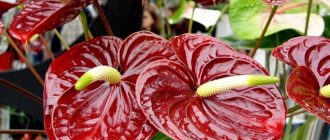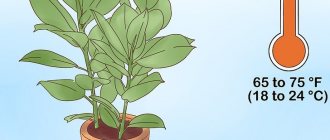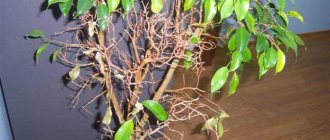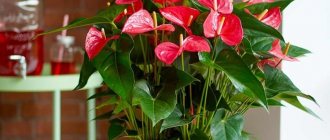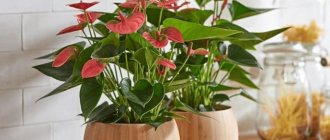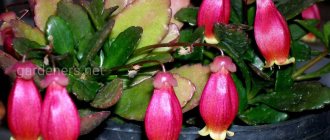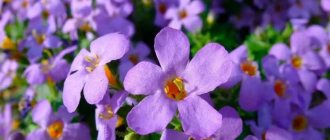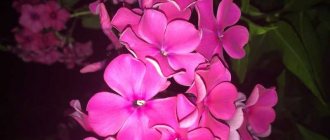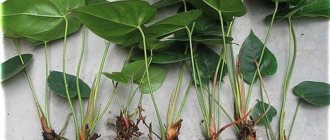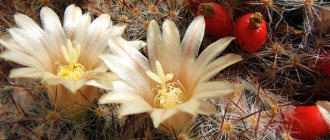Types of fertilizers
To feed anthurium, you can use organic, mineral and complex fertilizers, which contain organic and mineral fertilizers in an ideal ratio. But the fertilizer can be prepared at home using organic residues:
- Onion peel, which is used in the form of a decoction of 50 grams of peel and 2 glasses of hot water. This decoction is poured over the anthurium.
- Banana peel. It is filled with water, left for several days, and then the plants are watered.
- Wood ash. A solution of 1 tbsp. ash and one liter of water are watered at the roots of the plants twice a month.
Of the organic fertilizers that have proven themselves well:
- Mullein in the proportion of 1 tablespoon per 1 liter of water is used for irrigation throughout the year.
- Humus is used when replanting a plant, mixing it with the substrate 1:3.
- Bird droppings are used in dissolved form (1 tsp per 1 liter of water), as they are rich in chemical elements in an accessible form and help accumulate nitrogen.
For abundant flowering
- "Kemira Lux". Mineral complex for year-round use. One tablespoon of Kemira is dissolved in 10 liters of water and is used in the summer with every watering, in the winter every third or fourth time.
- "FORTE" for indoor plants. For watering, 1/4 of a cap of the drug is diluted in 1.5 liters of water. For spraying, 1/8 of a capful of solution is diluted in 1.5 liters of water. Apply from March to October once a week, in winter - once a month.
- "Agricola for flowering plants." Dissolve 1 tsp in three liters of water. agricola, water around the root or spray over the green mass.
For fast growth
- Growth regulator "Yantarin, vrk". The required amount of the drug is diluted in 1 liter of water, according to the attached instructions. The solution is watered or sprayed on the plants at intervals of twenty days. Increases plant resistance to diseases and pests, and also promotes growth.
- "Micromix". The drug contains all the micro and macroelements necessary for the development of anthurium. Based on it, a solution consisting of 10 grams is prepared. drug, 0.5 liters of water and 10-15 Urea granules. Spray per leaf, 50 ml. solution per 0.5 liter of water, 1-2 times a week. For root feeding 100ml. solution per 0.5 liters of water, watered once a month.
Plants are replanted once every 2 years.
To keep the leaves large
"FORTE" gloss for leaves.
Protects the leaf plate from pests, and also ensures the shine of the leaf plate due to the presence of silicone in the composition. The drug is in the form of a spray, which is sprayed onto the leaves after wiping them from dust. Sick plants should not be fed until they recover. If there are pests, you first need to get rid of them, and then apply fertilizer. Transplanted plants can be fertilized no earlier than two weeks after transplantation.
Reproduction
An overgrown anthurium, which is called male happiness, can and should be planted. There are two main ways to propagate anthurium: dividing the bush and cuttings.
The bush should be divided very carefully, resorting to this method as a last resort, but the apical and stem cuttings and side shoots, due to the presence of aerial roots on them, take root easily and quickly. In addition to the proposed methods, you can grow a plant from seeds.
Dividing the bush
The process is responsible and painstaking, since the root system of anthurium is very fragile and easily damaged. To divide the bush, you will need a sharp knife and a little patience.
- Release the plant from the pot and remove excess soil. If the root ball is dense and you can’t separate it without damaging it, you need to put the roots in a container of water for a while - this way they will become elastic and can be untangled.
- Inspect the roots for dark areas, rot, damage, and if present, remove them with a knife.
- Carefully cut the prepared bush with a sharp blade, sprinkle the cut points with crushed coal and plant them in different pots.
Cuttings
It is convenient to propagate the plant using “baby” cuttings grown on an adult bush. It is important to observe several conditions in order to get new healthy bushes in the future:
- the mother plant should be two to three years old, at least half a meter high;
- the length of the cutting for planting is 6-8 cm, it should have a growing point, a leaf and a fragment of the mother stem;
- You need to separate the cuttings with a sharp knife, and sprinkle the cut area on the mother bush with crushed coal.
If there are no aerial roots on the cutting, then there are several options for its further rooting:
- place the cutting in a container with water (it is important to ensure that it does not rot);
- keep the cutting in perlite, lightly moistening it with water;
- plant the cuttings in the ground (no deeper than 5 cm), cover with a glass cap, observe the necessary temperature and humidity conditions;
- Cover the cutting at the base with damp pieces of moss and wrap with cling film. This method is the most effective; after a week or a week and a half, the plant can be transplanted into a pot.
Growing from seeds
Breeding anthurium using seeds is the longest and most difficult path, however, it also has a right to exist. You need to understand that when grown from seeds obtained as a result of pollination of flowers, the result cannot be guaranteed: anthurium does not inherit varietal characteristics (the color of the bedspread, for example) of the parent bush.
Since the flowers are bisexual, and there are no insects for pollination, despite the bright color of the spathe, the process is carried out artificially, shaking off the pollen on the stigma. This should be done after the pollen has ripened and clearly visible pistils have appeared.
This happens around the end of the first week of flowering (not to be confused with the presence of a spathe, it only serves to attract insects), once every 2-3 days. If the result is successful, a knob-shaped thickening will appear on the cob, and the bright spathe will wither, since it will no longer be needed.
Only after 10-12 months will the seeds ripen. All this time, the bush has an unsightly faded appearance, without the usual bright “tails”. Ripe seeds are carefully removed from the fruit and washed with water, and then with a weak solution of potassium permanganate, dried and sown. At this time they have the greatest chance of germinating.
Before planting anthurium using any chosen method, you need to protect the skin of your hands with gloves and generally be attentive and careful - the plant is poisonous.
Purchasing drugs
When purchasing, you need to pay attention to the intended purpose and in what form the fertilizer is in. Fertilizer in granules has a longer validity period; in liquid form it is quickly absorbed, but acts for a short time. Here are the most popular drugs:
- “Azalea” (price from 123 rubles in Moscow), “Yantarine” (price 78 rubles);
- “FORTE” for indoor plants (price 100 rubles);
- “Kemira” (79 rubles per 1 kg), leaf spray “FORTE” in Moscow costs 260 rubles;
- “Agricola for indoor plants” (20 rubles).
Nutritional requirements
Anthuriums tolerate a lack of nutrients more easily than an excess. At the same time, fully providing the plant with the necessary nutrients has a beneficial effect on its decorative effect, flowering duration, and resistance to diseases and pests. When purchasing ready-made complex formulations for indoor plants at a garden store, you need to reduce the dosage recommended on the package by 2 times.
At home, anthurium needs to be fed once every 2 weeks in spring and summer, and once a month in autumn and winter. An excess of nutritional components should not be allowed, as this will negatively affect the condition of the plant and can lead to death. If this problem is suspected, it is necessary to urgently transplant the overfed specimen into fresh soil substrate, having previously washed the root system.
To avoid the anthurium roots getting burned by the concentrated solution, it is necessary to properly prepare the nutrient mixture, water the bush first with clean water, and only then with fertilizer.
Signs of nutrient deficiency in anthurium:
- nitrogen - the leaves turn yellow and crumble, the stems are thin and hardened, the buds are underdeveloped, the flowers are small and appear rarely;
- phosphorus - the plant slows down or stops growth, the leaf blade curls and acquires a purple tint;
- potassium - brown spots on the leaves, leading to their death, anthurium becomes highly susceptible to fungal infections and pests;
- calcium - the growth of an indoor flower slows down, the leaves become discolored near the petiole;
- iron and copper - young leaves turn pale;
- zinc – light spots, crushing of leaf plates;
- manganese - pale spots.
During active growth
In spring, anthurium begins to grow its above-ground part and prepare for flowering. For the first task, it needs nitrogen, but in small quantities, for the second - phosphorus and potassium. Throughout the entire period of active growth, the plant must receive the necessary microelements from the soil. A lack of nutrients can be determined by a change in the appearance of an indoor flower.
Anthurium is allowed to be fertilized only if it is completely healthy. Infected and pest-affected specimens must first be cured. Always combine the procedure with watering with settled water at room temperature, so as not to damage the root system.
During the flowering period
To set buds, nutrition must be supplied regularly; the supply of phosphorus complexes is of particular importance. During flowering, anthurium can be fed as before, but the concentration of the nutrient mixture should be less so that excess minerals do not lead to the shedding of inflorescences. It is not recommended to completely stop the procedures, since the plant can bloom for a long time, and it requires nutrition to maintain its decorative appearance.
At home, it is allowed to fertilize anthurium with universal mineral complexes by watering at the root.
How to feed anthurium
When growing this crop at home, it is necessary to provide the plant with proper care. After transplantation, the first 2-3 months do not require additional fertilizer if a nutrient substrate was used. After this, it is recommended to feed it with weakly concentrated solutions throughout the active growing season.
Fertilizers for flowers are available in several forms:
- liquid;
- pills;
- granules;
- powder;
- compressed cylinders.
Granular preparations are designed for almost the entire season. In the spring, they are scattered over the surface of the soil and mixed with the top layer, embedded shallowly. Dry fertilizers can supply anthurium with nutrients for several months, which must be taken into account when choosing this method of feeding.
Other products are recommended to be used in the form of solutions. Their effect is short-lived, often lasting no more than 2 weeks. For this reason, the procedure with such drugs is carried out regularly. It is important to take into account the dosage recommended on the package; for anthurium it is advisable to reduce it to 2 times.
There are remedies according to folk recipes. Simplicity, efficiency and accessibility are the main advantages of such fertilizers for anthurium at home. The main disadvantage is that it is impossible to measure the exact concentration of nutrients supplied to the plant.
Choosing fertilizer
The use of ready-made complexes for flowering indoor plants greatly simplifies feeding. Universal mixtures contain a sufficient amount of macro- and microelements and vitamins. Modern preparations additionally include humates. It is enough to dissolve such a remedy in boiled water and pour the resulting solution over the flower.
Fertilizers for anthurium:
- Fitosporin-M;
- Forte;
- Uniflor bud;
- Effecton for indoor plants;
- Yantarin, VRK;
- Kemira Lux.
Creating a favorable microclimate
The anthurium flower is often classified as a capricious crop that requires a special soil composition, a lot of light and warmth. But in fact, by providing it with the proper conditions and regular feeding, it can bloom continuously and please the eye for many years.
Optimal temperature conditions
For tropical anthurium, it is enough to maintain the temperature in the room within 20-28 degrees in summer, and 15-20 degrees in winter. If you want to see its luxurious flowers ahead of schedule, then you need to raise the temperature in the room to summer levels. But at the same time, you should give the plant time to set buds; the process occurs at a temperature of 16-18 degrees. Only after this can the air temperature be raised.
Indoor humidity
Anthurium grows and develops best at an air humidity level of 80%. Excess moisture has a detrimental effect on the exotic plant; its roots suffer from rot. An effective way to maintain suitable humidity for the crop is to place a tray filled with wet pebbles under the pot.
It is good to spray the leaves of “male happiness” with a spray bottle or simply wipe with a damp sponge or napkin. This must be done carefully so that water does not get on the inflorescences. Alternatively, by placing a humidifier next to the flower, you can normalize the humidity in the room, or use a container of water instead.
Lighting requirements
In order for the anthurium to bloom, it needs to be provided with soft and diffused light. In a dark room it loses all its beauty, fades and does not form inflorescences. You should also protect the tropical plant from direct sunlight, otherwise there is a high probability of burns on the delicate leaves, which can destroy it.
Video: Useful tips for caring for anthurium
It is recommended to place the flower pot either on the eastern side of the room or on the northwestern side. It happens that this cannot be done, then you can place it a meter from the window, in partial shade. In winter, “male happiness” really needs lighting; it is advisable to place it on the brightest windowsill, near a window facing south.
Short description
The ornamental anthurium plant looks very impressive, instantly attracting the eye: the flaming bract, which is considered to be a flower, is noticeable from afar and will certainly become a source of pride for the owner.
Proper flower care will make Men's Happiness a pearl in any collection.
Epiphytes, to which the plant belongs, live in the tropics, in a hot, humid climate. Aerial roots provide additional nutrition, so it is necessary to create conditions in the apartment that are close to natural.
What does it look like
It is almost impossible to confuse the anthurium flower with something else. A distinctive feature of the inflorescences is the cobs, which have an elongated shape (reminiscent of a spiral, cone, flattened ball, club) and surrounded by a brightly colored bract.
Smooth, like a varnished “sail”, dense to the touch. Varieties with scarlet bracts are popular, but this color is not a standard; plants with lilac, violet, dark (even black) and white “flowers” have been selectively bred. Along with the “sail”, the color of the cob also changes.
The dense, leathery leaves vary in shape, can be plain or mosaic, glossy or matte, but in any case they are quite large in size: in dense tropical forests, anthurium is forced to fight for sunlight.
And the epiphyte obtains nutrients and moisture with the help of aerial roots growing on the trunk under the leaves. They often cause headaches for owners, but if you figure out how to properly care for the plant, it will bloom at almost any time of the year.
Rest period
Anthurium is a delicate flower that requires special care. Strictly speaking, if optimal conditions are created, mainly sufficient lighting, it will please the eye all year round.
On thematic forums you can find categorical statements: a period of rest occurs only if the daylight hours are short and the temperature is not comfortable enough for an inhabitant of hot countries.
If there is no opportunity (or enthusiasm) to maintain year-round “tropics” in the apartment, you can give the plant a rest. In the autumn-winter period, watering is reduced, the temperature drops and “hibernation” sets in, which with the arrival of spring will again enter the active flowering phase.
Selecting a location
The best option for placing the flower would be the eastern part of the room near the window. The main thing is to avoid places where there are electrical appliances nearby, the radiation from which can absorb the positive energy of the plant. It is also prohibited to place it near sources of artificial heat or radiators.
In winter, it is good to remove anthurium in a bathroom that has a window. In such a place it will be able to receive sufficient humidity for growth and natural heat emanating from water evaporation. In the summer, a pot with an exotic crop is transferred to the living room or bedroom, where it decorates the space and receives suitable conditions for its existence. At the same time, it is important to know what to fertilize the anthurium so that it blooms.
Why doesn't male happiness bloom?
The flowering of male happiness continues from approximately February until October-November. It is also possible that flowering occurs twice - in spring-summer and autumn-winter.
If an anthurium does not bloom flowers, then this most often indicates failures in caring for it. Among the most common mistakes:
- The room is too cold (for anthurium even 15 degrees is extremely uncomfortable);
- Insufficient lighting;
- Too big pot;
- Abuse of mineral fertilizers. An indispensable attribute of such a mistake is blackened tips of the leaves;
- Poor quality soil. In this case, you should transplant the plant into another pot;
- Excessive watering. Then the leaves take on a distinct yellow tint.
In the last two cases, an additional negative factor may be a fungus that has settled on the plant.
Types of fertilizing
Novice gardeners often do not know how to feed anthurium at home, so they cannot achieve continuous flowering from this exotic crop. Mineral, organic, and universal compounds are used as fertilizers. But unlike the previous two, universal fertilizer has a high cost.
Effective organic fertilizers include:
- Mullein contains a complex of useful microelements, which will be relevant for use at any time of the year. You can feed the flower with a working solution prepared from 1 tbsp. l. products and 1 liter of water .
- Poultry manure , positioned as a valuable, potent fertilizer, is used in the form of a solution (1 teaspoon of raw material per 1 liter of water) .
- Humus , which is more suitable for supporting the plant after transplanting into another pot. It is used every two years. You can mix organic matter with the soil substrate in a ratio of 1:3 .
Considering the huge range of mineral compounds, floriculture lovers are lost in choice and do not know what to fertilize anthurium with and in what quantities. For tropical picky eaters, the most optimal are:
- Uniflor Bud , which is dominated by phosphorus and potassium. Fertilizer promotes faster formation of buds and prolongs the flowering phase.
- Azalea , characterized by its high nitrogen content. This composition is especially useful at the stage of active crop growth.
- Kemira Lux is a complex of minerals that can be used all year round.
It is important not only to know what to feed the anthurium, but also what dosage of the selected fertilizer will not harm it. You can feed adult flowers in the quantities specified in the instructions. But young plants need to be fertilized with half the dose.
It is very good at the stage of active flowering to carry out foliar feeding - on the leaves. The procedure can be carried out once every 7 days , for example with the complex composition of Doctor Foley Orchid . This will be quite enough.
When and how often should nutrients be added?
Anthurium is a flower that requires regular replenishment of micronutrients. Fertilizers need to be applied both in the spring and summer, and in the fall. The frequency of procedures is every two weeks.
But not everyone knows how to fertilize anthurium at home in order to make it bloom as long as possible. In winter, the plant is fed no more than once a month , since it is in a dormant state.
Fertilizer for anthurium should contain a whole range of useful microelements, given its luxurious large leaves and incredibly beautiful inflorescences. It is introduced only when the flower is completely healthy. If pests and signs of specific diseases were discovered, then first of all, you need to get rid of them, and then apply fertilizers.
Homemade fertilizers
The following fertilizing options based on:
This solution, prepared from ½ tsp. raw materials, 2 tbsp. l. sugar and 5 liters of warm water , it contains a large number of microelements and vitamins that have a beneficial effect on the growth and development of anthurium. The infusion period is 1 day , then the mixture is diluted with water in a ratio of 1:5 , watering is carried out at the root.
- Drinking coffee and brewing tea.
You can safely apply fertilizer twice a month . This feeding allows you to form strong roots and nourish the above-ground part.
- Citrus infusion.
For these purposes, you will need to grind the fruit peel and pour water over it and let it brew for two days .
- Wood ash.
The solution is prepared from 1 tbsp. l. raw materials and 1 liter of water . Watering is done twice a month under the roots.
- Onion peel.
For the decoction you will need 50 g of husk and 2 tbsp. l. hot water . After boiling the mixture for 10-15 minutes, it is allowed to brew for 3-4 hours. Before use, the broth must be passed through strainers and gauze.
